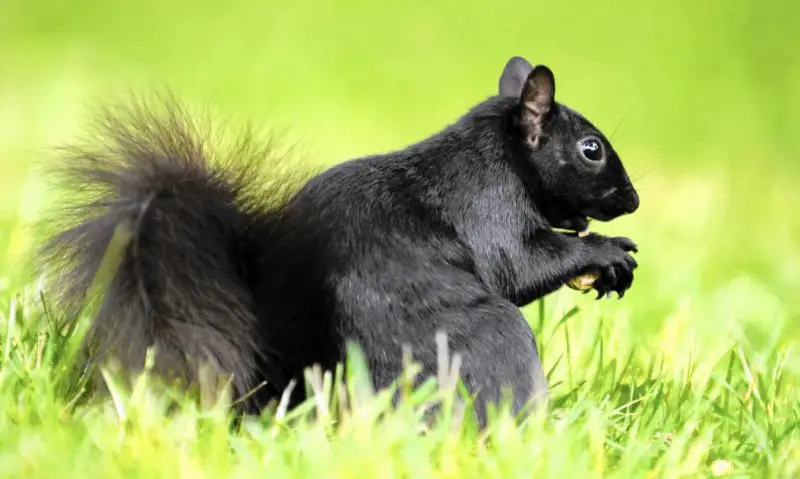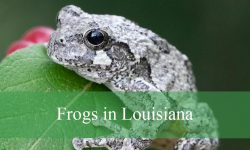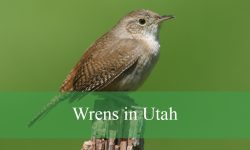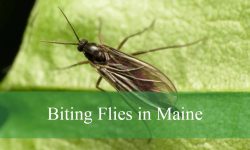While Illinois supports an impressive range of wildlife, few are as eye-catching as the black squirrel. With their striking dark coats and mysterious origins, black squirrels have long captured the curiosity of both scientists and everyday observers. Unlike the more common gray or red squirrels, these melanistic creatures stand out in city parks, suburban neighborhoods, and wooded areas. Their unusual color and unique adaptations have sparked interest not only in Illinois but across North America.
The presence of black squirrels in Illinois raises many questions. How did they develop such dark fur, and what advantage does it give them in survival? Are they a separate species, or just a color variation of familiar squirrels? To uncover these secrets, it’s essential to look deeper into their history, biology, behavior, and interactions with humans and the environment.
This detailed guide will explore the world of black squirrels in Illinois, shedding light on their appearance, survival strategies, habitats, and the scientific explanations behind their striking coats. Along the way, we will also consider their role in local ecosystems and why their population continues to intrigue researchers and nature enthusiasts alike.
The Origins of Black Squirrels in Illinois

Historical Accounts and Distribution
The black squirrel is not a separate species but rather a melanistic form of the eastern gray squirrel (Sciurus carolinensis) or the fox squirrel (Sciurus niger). In Illinois, both these common species can produce individuals with dark fur, though they are less frequent compared to their lighter relatives. Historical records suggest that black squirrels were once more widespread across the Midwest, but as forests were cleared and habitats changed, their numbers declined.
In Illinois, sightings of black squirrels are most frequent in northern and central parts of the state. Cities such as Rockford, Bloomington, and certain neighborhoods of Chicago have reported stable populations. Smaller towns with connected green spaces also provide refuges where these unique squirrels can thrive. Their presence is not random; it often relates to historical introductions, genetic factors, and the availability of suitable habitats.
Genetic Basis of Melanism
The dark coat of black squirrels is the result of a genetic mutation that increases the production of melanin, the pigment responsible for hair, skin, and eye color. This genetic trait is inherited, meaning that if two carriers mate, there is a higher chance of producing offspring with the black coat. Interestingly, the gene responsible for melanism in squirrels is believed to have originated through interbreeding between eastern gray squirrels and fox squirrels thousands of years ago.
In Illinois, the balance between black and gray squirrels depends on local environmental pressures. In some towns, black squirrels dominate, while in others, they are rare curiosities. This uneven distribution is one of the most intriguing aspects of their presence in the state.
The Unique Appearance of Black Squirrels
Distinguishing Features
Black squirrels are instantly recognizable due to their glossy, dark coats, which range from jet black to a slightly brownish-black hue. Their fur is often thicker and shinier compared to their gray counterparts, making them stand out even more in the landscape. Apart from their coloration, however, black squirrels share the same size, body shape, and physical features as gray squirrels. They typically measure between 9 to 12 inches in body length, with bushy tails that add another 7 to 10 inches.
Despite their unusual appearance, they are not difficult to identify. In Illinois, where gray squirrels are the dominant type, spotting a black squirrel can be a thrilling experience for wildlife watchers. Their striking contrast against autumn leaves, snow-covered grounds, or green summer foliage makes them highly visible.
Seasonal Advantages of Their Coat
The dark fur of black squirrels may offer seasonal survival benefits. During the colder months in Illinois, their melanistic coat absorbs more heat from sunlight, giving them a slight advantage in thermoregulation. This could help explain why black squirrels are often more common in northern regions, where winters are harsher.
Conversely, in summer, their dark coats might make them more prone to overheating. However, squirrels are highly adaptable, and behavioral adjustments such as seeking shade, remaining active during cooler parts of the day, and using their tails as heat shields help them balance the disadvantages of their dark fur.
Habitat and Range in Illinois
Preferred Environments
Black squirrels in Illinois occupy a wide range of habitats, from urban parks to rural woodlands. They thrive in areas where mature trees provide both food and nesting sites. Oak, hickory, and maple trees are particularly important since they produce the nuts and seeds that form the bulk of the squirrel’s diet.
Urban environments in Illinois often provide unexpected advantages for black squirrels. City parks, university campuses, and tree-lined neighborhoods offer food sources such as acorns, ornamental fruits, and even discarded human food. Reduced predation pressure and fewer natural competitors can also allow their populations to flourish in these man-made settings.
Geographic Hotspots in the State
While black squirrels can be found across Illinois, certain regions are more notable for their concentrations. Northern Illinois, with its mix of suburban and forested landscapes, supports a relatively high density. Central Illinois towns and college campuses have also become strongholds, where localized populations remain stable year after year. In southern Illinois, black squirrels are less common but can occasionally be spotted in forested parks and nature preserves.
Behavior and Lifestyle of Black Squirrels
Feeding Habits
Like gray and fox squirrels, black squirrels are omnivorous, though their diets are primarily plant-based. They rely heavily on nuts, seeds, berries, and fungi, which they collect and store for winter. Their habit of burying acorns and other nuts plays a significant role in forest regeneration, as forgotten caches often sprout into new trees.
In urban Illinois environments, black squirrels readily adapt to supplemental food sources. They raid bird feeders, forage for discarded food in trash bins, and even accept offerings from humans. This opportunistic feeding behavior contributes to their success in populated areas.
Nesting and Social Structure
Black squirrels build nests, known as dreys, in the branches of tall trees. These structures are made from twigs, leaves, and soft materials, offering insulation against the cold. In winter, they sometimes take refuge in tree cavities, which provide additional protection.
Although squirrels are generally solitary, they may tolerate each other’s presence in areas with abundant food. During the breeding season, males actively pursue females, often engaging in high-energy chases through the treetops. Litter sizes in Illinois usually range from two to four offspring, with mothers providing intensive care until the young are ready to leave the nest.
The Survival Secrets of Black Squirrels
Predation and Natural Threats
Despite their bold coloration, black squirrels face similar predators to gray and fox squirrels. Hawks, owls, foxes, and coyotes are their primary natural threats in Illinois. Their dark coats may provide camouflage in shaded forests, especially in winter when the contrast against snow is less pronounced than expected.
In urban environments, black squirrels encounter additional risks from vehicles, domestic cats, and habitat loss. However, their adaptability and ability to exploit human-dominated landscapes have helped them maintain a steady presence in many Illinois towns and cities.
Advantages of Melanism
The genetic mutation that gives black squirrels their color also appears to offer physiological benefits. Studies suggest that black squirrels may have stronger immune systems compared to gray squirrels, making them more resilient against certain diseases. Their ability to absorb and retain heat also gives them an edge in colder climates, which may explain their higher prevalence in northern Illinois compared to the southern part of the state.
Over time, these advantages could contribute to the persistence and even expansion of black squirrel populations in Illinois.
Interactions with Humans
Cultural Fascination
In many Illinois communities, black squirrels are more than just wildlife—they are local mascots and symbols of uniqueness. Some towns celebrate their presence with festivals, while others use them in school or sports team logos. Their rarity compared to gray squirrels makes them a point of pride for areas where they are especially abundant.
Residents often share stories and photos of black squirrels, fueling curiosity and appreciation for these unusual creatures. Their charismatic appearance and playful behavior make them particularly popular among wildlife photographers and nature enthusiasts.
Conservation and Human Impact
Although black squirrels are not endangered, their survival is linked to the preservation of suitable habitats. Urban expansion, deforestation, and increased traffic pose challenges to their populations. On the other hand, human activity has also created safe zones for them in parks, campuses, and suburban neighborhoods.
In Illinois, conservation efforts aimed at protecting overall biodiversity indirectly benefit black squirrels. By maintaining green corridors, reducing pesticide use, and planting native trees, communities help secure the resources these animals depend on.
Black Squirrels and the Illinois Ecosystem
Role in Seed Dispersal
One of the most significant ecological contributions of black squirrels is their role in seed dispersal. By burying nuts and forgetting some of their caches, they inadvertently plant new trees, aiding forest regeneration across Illinois. This process benefits a wide range of species, from birds to insects, by sustaining healthy forest ecosystems.
Competition with Other Squirrels
Black squirrels coexist with gray and fox squirrels, and their interactions can be complex. In some Illinois regions, black squirrels appear to outcompete gray squirrels, possibly due to their greater tolerance for cold. However, in warmer parts of the state, gray squirrels tend to dominate. These subtle shifts in population dynamics illustrate how even small genetic differences can influence broader ecological patterns.
Myths and Misconceptions About Black Squirrels
Are They a Separate Species?
A common misconception is that black squirrels are a distinct species. In reality, they are simply a color variation of existing squirrel species, primarily the eastern gray squirrel and fox squirrel. Their genetic difference lies only in pigmentation, not in other physical or behavioral traits.
Do They Bring Good Luck?
Folklore in some Illinois communities portrays black squirrels as symbols of luck or mystery. While such beliefs are not grounded in science, they reflect the deep connection between people and the wildlife that surrounds them. These stories contribute to the cultural identity of towns where black squirrels are common, adding to their allure and local importance.
The Future of Black Squirrels in Illinois
Population Trends
Current trends suggest that black squirrel populations in Illinois are stable and, in some areas, even increasing. Their adaptability to urban and suburban landscapes ensures they remain visible in many communities. Climate change may also play a role in shaping their future distribution, as colder winters historically favored their survival, but warming conditions could shift population balances over time.
Ongoing Research
Scientists continue to study black squirrels to better understand the advantages of melanism and its implications for survival. Illinois, with its mix of urban and rural environments, offers a valuable case study for these investigations. The presence of thriving black squirrel populations in certain areas provides opportunities to explore genetic diversity, adaptation, and ecological impact.
Conclusion
Black squirrels in Illinois are more than just a genetic anomaly—they are living examples of adaptation, resilience, and the intricate interplay between wildlife and environment. Their striking appearance sets them apart from the common gray squirrel, while their survival strategies highlight the hidden advantages of their melanistic coats.
From urban parks to forested preserves, these creatures continue to thrive, shaping ecosystems and captivating the people who encounter them. As Illinois communities grow and change, the story of the black squirrel reminds us of the importance of coexistence with the natural world and the enduring mysteries that still await discovery in our own backyards.
FAQs About Black Squirrels in Illinois
Are black squirrels common in Illinois?
Black squirrels are not as common as gray or fox squirrels in Illinois, but they are regularly spotted in certain regions. Northern and central Illinois tend to have higher populations, particularly in towns with large tree cover or on university campuses where these squirrels have become a familiar presence. In southern Illinois, sightings are rarer, but they still occur in wooded areas and parks.
Are black squirrels a different species?
No, black squirrels are not a separate species. They are a melanistic form of either the eastern gray squirrel (Sciurus carolinensis) or the fox squirrel (Sciurus niger). Their unique black coat comes from a genetic mutation that increases melanin production in their fur. Apart from their color, they share the same size, habits, and behaviors as their lighter relatives.
Why do some squirrels in Illinois have black fur?
The black coat in squirrels is caused by a genetic mutation that leads to excess melanin production. This trait can be inherited when both parents carry the gene. Scientists believe that melanism may have survival benefits, especially in colder climates. The dark fur allows black squirrels to absorb more heat from sunlight, which helps them conserve energy during harsh Illinois winters.
Do black squirrels live in cities or only in forests?
Black squirrels adapt well to a variety of habitats in Illinois. They live in forests, woodlands, parks, and suburban neighborhoods. Urban areas often provide ideal conditions because food is plentiful, predators are fewer, and trees or green spaces serve as safe nesting sites. In fact, many city residents in Illinois see black squirrels more often than in rural areas.
What do black squirrels eat in Illinois?
Black squirrels have a varied diet similar to gray and fox squirrels. They primarily eat acorns, hickory nuts, seeds, fungi, and fruits. In urban areas, they also consume birdseed, ornamental fruits, and even food scraps left by humans. Their foraging and nut-burying habits play a crucial ecological role in replanting trees and supporting forest regeneration.
Are black squirrels aggressive?
Black squirrels are not more aggressive than gray or fox squirrels. They may appear bolder around humans because of their adaptability to city life, but their behavior is generally the same as other squirrels. During the breeding season, males may chase each other in competitive displays, but this is typical of all squirrel species.
Can black squirrels survive better in Illinois winters?
Yes, their dark fur can give them a survival advantage in cold Illinois winters. The black coat absorbs more sunlight, allowing them to stay warmer and conserve energy. This trait may explain why black squirrels are more common in the northern parts of Illinois, where winters tend to be harsher compared to the southern regions of the state.
Are black squirrels protected in Illinois?
Black squirrels are not a protected species in Illinois since they are simply a color variation of common squirrels. However, local communities often value them and sometimes informally protect their populations. Conservation efforts aimed at preserving urban green spaces and forests indirectly support black squirrel populations across the state.
Where is the best place to see black squirrels in Illinois?
Black squirrels can be spotted in several northern and central Illinois towns, including Rockford, Bloomington, and certain neighborhoods of Chicago. College campuses, public parks, and tree-filled neighborhoods are some of the best places to find them. Visiting during early morning or late afternoon, when squirrels are most active, increases the chance of sightings.







We have a lot of them in northern cook county in the suburbs